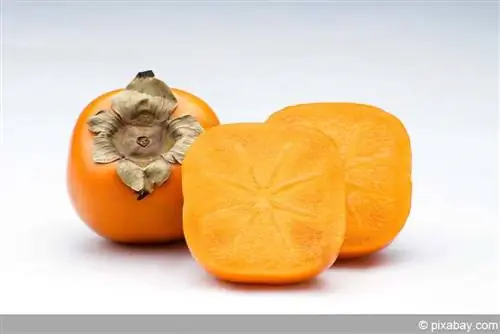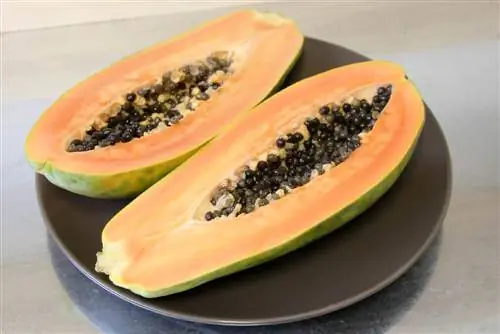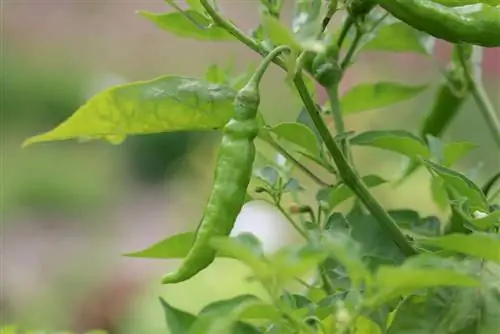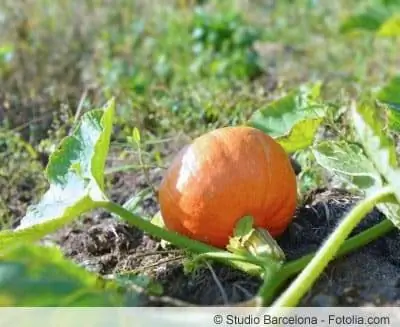- Author admin [email protected].
- Public 2023-12-17 03:39.
- Last modified 2025-01-24 12:45.
Bamboo belongs to the sweet grass family and is native not only to China, but all over the world with the exception of Europe and Antarctica. There are 47 different species with around 1200 varieties, of which only around 20 are suitable for cultivation in Central European gardens. Many bamboo species cultivated here only bloom about once every 100 years, making seed collection and subsequent propagation difficult.
Bamboo is not the same as bamboo
The real bamboo (Latin Bambusa) is rarely found in Central European gardens due to the climatic conditions. Instead, various hardy varieties of the two genera Phyllostachys (flat reed bamboo) and Fargesia (umbrella bamboo) are cultivated in this country. These are generally uncomplicated to care for, although the Phyllostachys species should be prevented from spreading uncontrollably using a special root barrier. Propagation usually takes place via division, but rarely - and only possible in a few species - also via cuttings.
Bamboo blooms extremely rarely
Collecting seeds and propagating them is very difficult due to the extremely rare flowering of the two most commonly cultivated bamboo genera, Phyllostachys and Fargesia. These species only bloom once, about 100 years apart, although specific periods cannot be specified. As a rule, almost all specimens of a species bloom at approximately the same time - worldwide. The reason for this rare flowering has not yet been scientifically determined, but there are speculations: Through these extremely long periods of time, the plant genus ensures that certain animal species cannot specialize in eating the seeds - and thus ensure the survival of the species secure.
Other genera and species of bamboo, on the other hand, bloom more frequently, but also only at intervals of at least 12 years to several decades. After blooming for several years, many plants eventually die due to a lack of nutrients, but they self-seed beforehand. This is especially true for Fargesia, which last bloomed in the 1990s or around the turn of the millennium.
Harvesting bamboo seeds
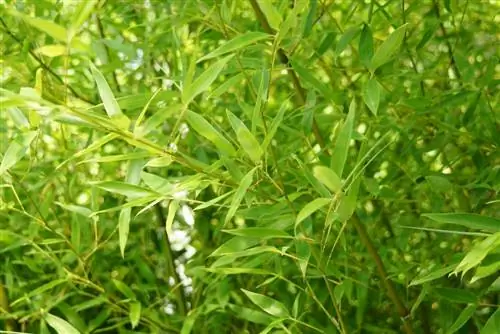
When bamboo flowers, it does so over a period of about two to five years. Meanwhile, the plant keeps producing new flowers in spring, but no new leaves appear. As a result, the bamboo becomes bare and eventually dies. After fertilization, these flowers develop into seeds that can be harvested towards the end of summer or autumn. Unfortunately, the seeds of the more common flowering bamboo species often turn out to be sterile and therefore unable to germinate. First dry the seeds you have harvested yourself for one to two days, then let them soak in a warm water bath for a few hours and plant them promptly.
Guide to Harvesting Bamboo Seeds
- Harvest only possible after rare bamboo blossoms
- Flowering occurs cyclically at intervals of several decades
- Flowering cannot be provoked - it only helps to wait
- collect ripe seeds at the end of summer / in autumn
- Clean seeds carefully with a soft, dry cloth
- Let seeds dry for one to two days
Sow the seeds as freshly as possible, as they lose their ability to germinate over time.
Buy fresh seeds if possible
This is especially true if you want to buy and sow seeds. Research the flowering times of the bamboo species and variety you want to determine the best time to purchase seeds. The fresher the seeds are, the higher the germination rate. The seeds of the very popular Moso giant bamboo (Latin Phyllostachys edulis or Phyllostachys pubescens) are mainly harvested in the months of October and November, so you should not necessarily purchase them until autumn of the following year. Fresh seeds can only be available if the bamboo species in question is currently in a flowering cycle.
Growing new bamboo plants from seeds
If you have purchased bamboo seeds, you will receive the appropriate growing instructions for the species and variety. The exotic, tropical species in particular require high temperatures of over 26 °C in addition to high humidity in order to germinate successfully. For our winter-hardy bamboo species, however, temperatures between 16 and 24 °C are sufficient. Growing plants from seeds is generally possible all year round, but you should ensure a sufficient supply of light. To do this, place the breeding station directly next to a bright window (a south-facing window is ideal).
Tip:
During the dark winter months or for growing in a dark room, installing a plant lamp can make sense, although you don't necessarily have to resort to expensive special lamps. For bamboo, simple, warm white fluorescent tubes are sufficient.
Preparing seeds
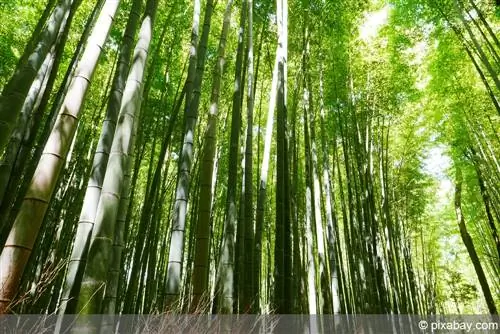
Before you sow the seeds, you should first let them soak in a glass of lukewarm, clean water for six to twelve hours - preferably overnight. If you don't have fresh seeds but older ones, you can peel them to improve germination. Of course, this doesn't happen in nature, but the seeds aren't stored there for months or even years.
Tip:
Growing methods vary
If you are unsure, you can also divide the existing seeds and treat them differently. This way you can also check which cultivation method works best for you. For example, you can soak some of the seeds, some not, and allow some seeds to germinate on cotton wool like cress, while others germinate on sandy substrate in the indoor greenhouse. Feel free to experiment, as many types of bamboo are difficult to coax out of their hard shells to germinate.
Prepare the substrate and plant containers
When it comes to the substrate, use sandy potting soil that is as low in nutrients as possible, although so-called growing pads (for example made of coconut fiber) are also very suitable. These simply need to be pre-soaked in water and can then be placed in the prepared planters. You can use special growing plates, but also small pots or yogurt cups. The only important thing is that the containers are thoroughly washed and clean so that no germs or mold can ruin the germination success.
Planting and caring for seeds
Since all bamboo species germinate in the light, you must not plant the seeds directly. Instead, simply place them on the moistened substrate and definitely do not cover them with soil. Some guides recommend covering them lightly with bird sand, but this is also not recommended due to the poorer germination rate. You can plant several seeds in one container. Then care for the seeds as follows:
- Always keep the substrate slightly moist
- Substrate must not be wet=otherwise seeds will rot
- Moisten the substrate with a spray bottle
- Keep humidity high
- Cover the planter with cling film, a cut PET bottle or similar
- Indoor greenhouse with or without heating is also very suitable
- ventilate several times a day to prevent mold formation
- Place the planter in a bright and warm place - but not in direct sunlight

These cultivation rules apply in principle to all types and varieties of bamboo and only vary in detail (for example with regard to the ambient temperature). The seeds germinate within one to two weeks, but depending on the species, variety, growing conditions and age, they can take several months to a year to develop the first delicate greens. So if in doubt, be patient and don't throw in the towel straight away if germination doesn't work straight away.
Tip:
Since young bamboo plants are very sensitive to moisture, you should actually only keep the substrate very slightly moist. The potting soil must not dry out, otherwise germination cannot take place.
Caring for and planting seedlings
After germination, only a single cotyledon appears (and not a pair of leaves, as in many other plant species). If this cotyledon can be seen and the small bamboo has already grown a bit, you can carefully separate the plants and place them in small pots with a suitable, nutrient-poor substrate. When moving, do not remove the seeds under any circumstances, but instead cover them with soil.
Continue to keep the plantlets under ventilated air (i.e. under foil) and make sure that they are not exposed to direct sun for the first few months. If the substrate is finally well rooted, you can move the young plants into a larger pot with suitable bamboo soil. You can start fertilizing as soon as the first real leaves appear. For this purpose, use special bamboo fertilizer, although lawn fertilizer is also suitable (caution: choose a brand without moss killer!). However, fertilize very sparingly at first.
When can the seedlings go outdoors?
Whether and when the young bamboo plants can go outdoors depends on their size, the prevailing weather conditions and, above all, the specific species. As a rule, you should first cultivate young bamboo in pots and only plant out winter-hardy species such as Fargesia and some Phyllostachys in late spring / early summer after the last night frosts. Many other bamboo species (including the popular Phyllostachys edulis or Moso giant bamboo as well as tropical species such as Bäumea or Dendrocalamus) are not hardy and should therefore be cultivated in pots anyway. During the cold season they have to spend the winter frost-free in the winter garden or similar, but they can go outside without worrying about it during the summer months.



